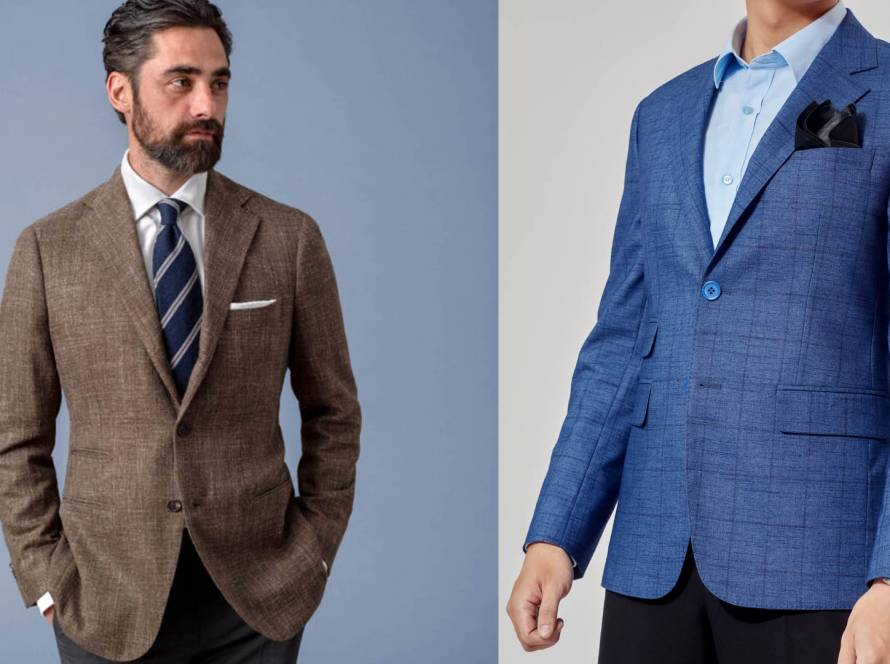Suit fabrics is one of the most confusing and hardest obstacles that everyone has to face when buying a suit.
With fifty shades of grey (no pun intended) and over 70 of blue, from checkered fabric to pinstripes, it is natural for clients to get overwhelmed, mystified and even baffled. But the experience of getting a suit stitched does not have to be thorny at all. Let this simple guide be a handy tool when you are out making your next suit.

Table of Contents
1. Pick the right suit to match your skin tone

2. Suit your shape
For the Shorter Men:
- Stick to a two button jacket in order to elongate your torso
- Wear a single colour (matching jacket and pants) to help length your body without any visual breaks
- Have your pants tapered with a neat cut and wear it slightly above the hip bone to add length to the legs
- Avoid long jackets, drop crotches wearing a suit as separates
For the Taller Men:
- Steer away from cropped jackets and pants to avoid looking like you outgrew your suit
- Avoid over-sized, padded shoulders that will swallow you up and diminish your build
- Try out lighter colours that add width to a narrow frame, as does a double breasted jacket
- Avoid wearing skinny ties – slim widths won’t appear to elongate an already long torso
For the Slimmer Men:
- Stick with a slim lapel so that it’s in proportion with the rest of your frame
- Try adding bulk to your narrow frame with a double breasted suit
For the Larger Men:
- Avoid wearing an over-sized suit – you need to look slimmer and also sleek (roomy is not sleek)
- Opt for a two button suit that will highlight your shoulders and length your torso (immediately helping you to look slimmer)
- Avoid wearing checkered – simple solid colours or pinstripes are the way to go. Vertical lines streamline the body physique and draw eyes up and down
For the Muscular Men:
- Avoid wearing peak lapel – there is no need to accentuate an already broad shoulder and chest
- Aim to strike a right balance between a tapered waist and a correct fit across the shoulder area
- Due to your already muscular and bulkier build, opt for a tailored suit without shoulder padding for a soft, natural shoulder drape

3. Select the colour based on the occasion
For a Business Formal Setting:
- Navy blue and the dark and light shades of grey are ideal. They do not distract from the personality and fit well into the situation.
- If blue and grey sound like limiting your options, walk into a tailor’s boutique and you’d be surprised to see the number of shades you can choose from.
For a Business Casual Setting:
- To play around with colours, it is a good idea to try suit separates. Imagine you have two suits. One grey, one blue. If you interchange the pants, you now have four different outfits.
- As long as you’re confident with the colour matching scheme (like how grey and blue compliment each other, black and brown are blasphemy!), you can choose your suit colours based on what you already have and mix around your attire.
For a Wedding:
- Flashy colours (as long as they don’t look absurd) can be an option. My personal favourite for day time weddings is a pastel blue suit jacket matched with khaki pants.
4. Pattern and formality
If you are out buying your first suit, a solid woolen fabric is a safe bet. These fabric are the most common ones and are not very flamboyant. They are versatile and best suited for daily workwear.
For those looking for depth in their attire, Birdseye and Herringbone and good textures that add definition to your look. These patterns give a two colour tone. Both named after what they resemble, Birdseye is somewhat oval and Herringbone is zigzag. These designs are interesting, but somewhat best for smart casual attire.
More obvious patterns are the windowpanes (checkered) and pinstripes. Pinstripes are good to wear in corporate environment, but what must be kept in mind is the distance between the lines. Too much distance and you may appear shorter than you are. As for checkered, they are best for casual settings and may look good on lighter colour fabric.

5. Completing the look





